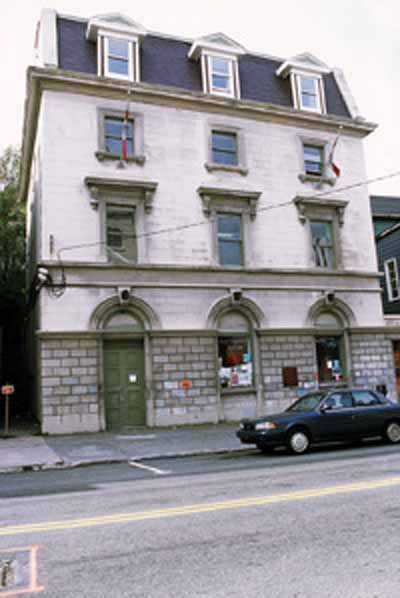Former Bank of British North America National Historic Site of Canada
St. John's, Newfoundland and Labrador

General view
(© Parks Canada/Parcs Canada, 2002)
Address :
276 Duckworth Street, St. John's, Newfoundland and Labrador
Recognition Statute:
Historic Sites and Monuments Act (R.S.C., 1985, c. H-4)
Designation Date:
1991-10-01
Dates:
-
1848 to 1850
(Construction)
-
1848 to 1985
(Significant)
-
1892 to 1894
(Significant)
-
1885 to 1885
(Significant)
Event, Person, Organization:
-
British Bank of North America
(Organization)
-
Commercial Bank of Newfoundland
(Organization)
-
Bank of Montreal
(Organization)
-
Newfoundland Savings Bank
(Organization)
-
David Stirling
(Architect)
Other Name(s):
-
Former Bank of British North America
(Designation Name)
-
College of the North Atlantic's Anna Templeton Centre
(Other Name)
Research Report Number:
1991-007
Plaque(s)
Existing plaque: right of main doors 276 Duckworth Street, St. John's, Newfoundland and Labrador
This Italianate style building recalls the evolution of banking in Newfoundland. Designed by Halifax architect David Stirling for the Bank of British North America, it opened in 1850 at a time when British investors controlled banking in the colony. Subsequent local ownership by the Commercial Bank (1857-1894) and the Savings Bank (1897-1962) points to a long and vibrant period when Newfoundland investors shaped the colony's financial institutions. The Bank of Montreal then operated here until 1985, bringing to a close the building's remarkable 135-year history as a bank.
Description of Historic Place
The Former Bank of British North America National Historic Site of Canada is located within the Heritage Conservation Area of St. John’s, Newfoundland. This impressive three-and-a-half-storey brick building with a mansard roof, stone façade, and Italianate features housed Newfoundland’s major banks from 1849 to 1985. Today it is occupied by the College of the North Atlantic’s Anna Templeton Centre as a learning facility. Official recognition refers to the legal limits of the property at the time of designation.
Heritage Value
The Former Bank of British North America was designated a national historic site of Canada in 1991 because: its close associations to the evolution of banking in Newfoundland; this Italianate style recalls the evolution of banking in Newfoundland.
The heritage value of the Former Bank of British North America resides in its long-term association with banking in Newfoundland. The building’s status is reflected in its Italianate style, its substantial institutional presence in both the interior and exterior, its composition, and its site and setting.
The Former Bank of British North America was built in 1849 to plans by Halifax architect David Stirling. Constructed in the Italianate style, a style popular in Canada during this period for commercial architecture including banks, it housed Newfoundland’s first commercial bank (founded in 1835) from 1849-1857. After that, it continued to be occupied by major banking operations for more than a century: the new Commercial Bank of Newfoundland (1857-1894), the Bank of Montreal (1895-1897), then the Newfoundland Savings Bank (1897-1962) and again the Bank of Montreal (1962-1985). A mansard roof was added to the building in 1885, leaving its original exterior largely intact. The bank’s interior was destroyed by the Great Fire of St. John’s and rebuilt in 1892-1894.
Source: Historic Sites and Monuments Board of Canada, Minutes, June 1991.
Character-Defining Elements
Key features contributing to the heritage value of this site include: its rectangular footprint and cube-like three-and-a-half storey massing; its mansard roof with dormers; the organization of its main façade in three equal bays, each topped by a pedimented dormer; its diminishing layered horizontal composition, with stringcourses, and progressively lower and less ornate levels from bottom to top; its Italianate style features, notably its ground floor faced with rusticated stonework and tall segmentally-arched windows decorated with lion heads, its ornate Renaissance style window surrounds with carved brackets on the second floor “piano nobile”, its smaller square third-storey windows, and prominent moulded cornice with scrolled brackets supported on carved pilasters; its original exterior materials including stone facing over brick walls on the ground floor façade, and brick above with finely crafted details; surviving 19th-century interior layout and finishes, notably its rich late Victorian furnishings and fittings of wood, plaster, panelling, tile, stained glass and pressed metal; the continuity of long-term access and circulation patterns; the bank’s sympathetic setting in the St. John’s Heritage Conservation Area.